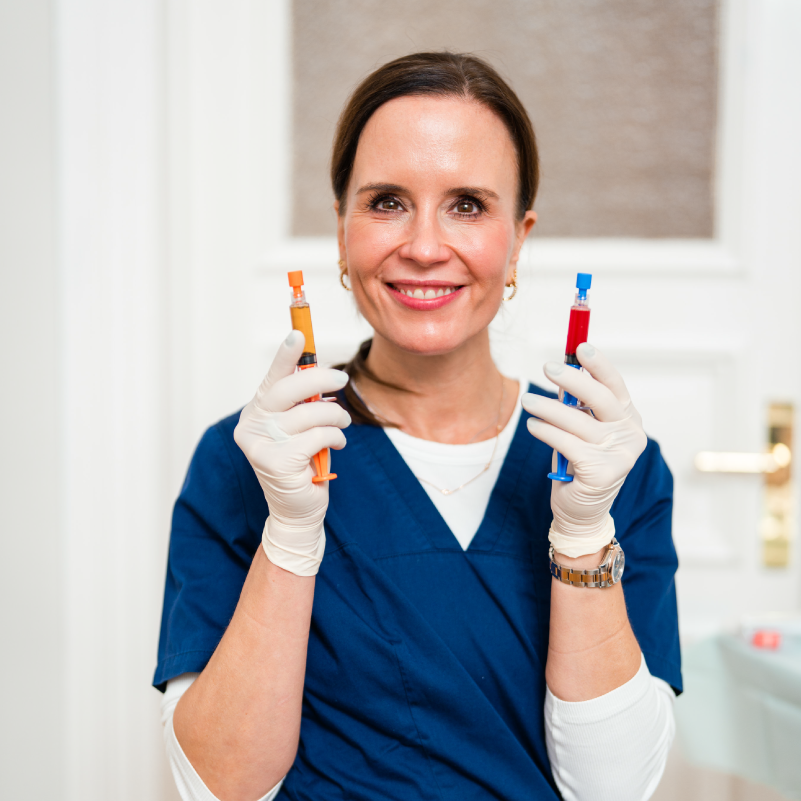Treatment Duration | 60 Min |
|---|---|
Socially Presentable | immediately |
Durability | 12–18 months
|
Pain | moderate
|
Interval
| 12 months
|
Contraindications | infection, coagulation disorders, use of anticoagulants
|
|---|---|
Preparation | blood draw
|
Aftercare | sun protection |
UV abstinence
| 1 week |
The growth factors contained in PRP are essential proteins that accelerate tissue healing and regeneration. They promote cell division, the formation of new blood vessels, and the production of collagen — a key element for firm, elastic skin and strong hair growth. The most important growth factors include FGF, PDGF, TGF-ß, EGF, VEGF, and IGF, all of which are involved in stem cell migration, differentiation, and proliferation. In addition, platelets stimulate fibroblasts and endothelial cells to form new extracellular matrix and support neovascularization. Blood plasma also contains a variety of nutrients such as vitamins, electrolytes, hormones, and proteins that support cell proliferation and tissue formation. Furthermore, PRP has been shown to exhibit pain-relieving, anti-inflammatory, and antimicrobial properties.

PRP is an effective method for skin rejuvenation, as it naturally stimulates skin renewal. Depending on the treatment technique, the freshly prepared PRP is injected, applied, or gently massaged in, triggering regeneration and cell renewal in the skin, tissue, or hair follicles. Numbing the skin before injection is not necessary, as very fine mesotherapy needles are used.
This therapy is particularly suitable for:
PRP stimulates the body’s own collagen production, visibly smoothing fine lines and wrinkles.
Whether acne or surgical scars — PRP treatment in Hamburg refines the skin’s texture and softens the appearance of scars.
By improving skin structure and cell regeneration, PRP can refine the complexion and visibly minimize pores.
PRP therapy is particularly effective for hair loss, as it revitalizes the hair follicles and supplies the roots with essential nutrients.
PRP can slow down hormonally induced hair loss and, in many cases, stimulate new hair growth.
Uniform hair loss caused by stress, nutritional deficiency, or hormonal changes can also be slowed with PRP, while strengthening the hair roots.
PRP improves hair structure and promotes strong, healthy hair growth.
Supports faster healing and enhances the survival rate of transplanted hair.
The PRP procedure is minimally invasive and takes about 45 to 60 minutes. We recommend an initial course of three sessions spaced four weeks apart, followed by maintenance treatments every three to six months as needed.
The treatment process includes:
A small amount of blood is drawn from the arm vein.
The sample is centrifuged to separate and concentrate the platelet-rich plasma.
The PRP is injected into the skin or scalp using fine mesotherapy needles.
Avoid makeup and strong sun exposure for several hours following the treatment.
With PRP therapy (also known as the “vampire lift”), our dermatology practice offers patients a particularly natural and gentle method to achieve rejuvenated skin and fuller hair. It serves as an effective alternative to BTX and fillers, allowing us to activate and support the body’s own regenerative powers.
If you’d like to learn more about PRP treatment in Hamburg or are unsure whether this method is right for you, book your appointment online or by phone — we’ll guide you every step of the way, from your first question to your renewed glow.
Doctors with Heart and Experience
Modern Dermatology & Aesthetics
Heilwigstraße 33, 20249 Hamburg
We use cookies to optimize our website and our service.
Under settings, you will find detailed information and can make your choices. You can revoke or adjust your selection at any time in the cookie manager at the bottom right of the page.